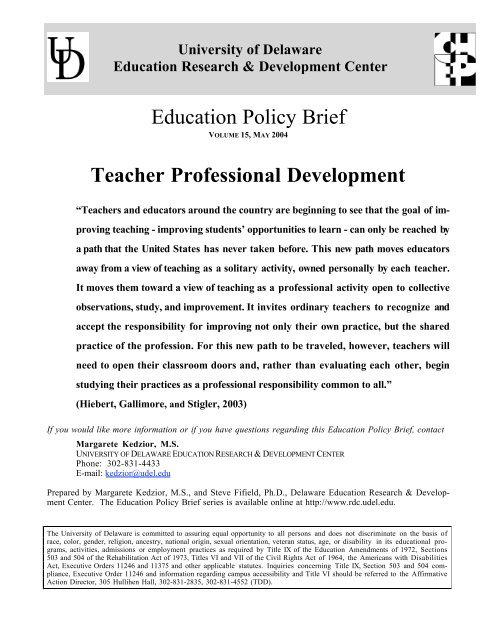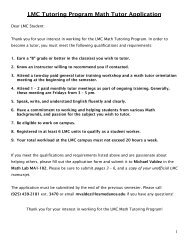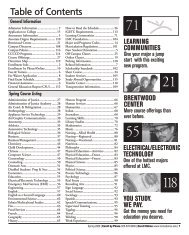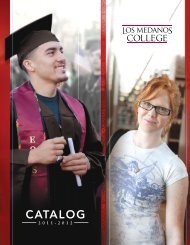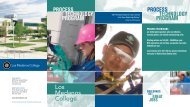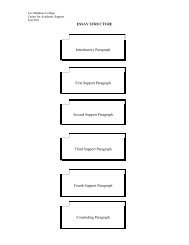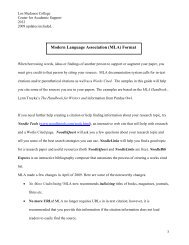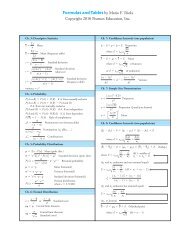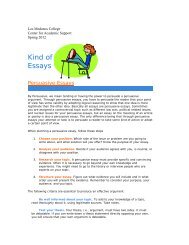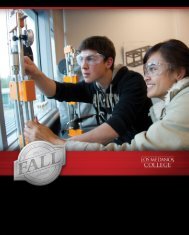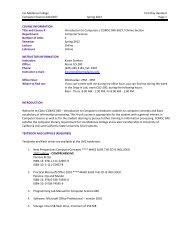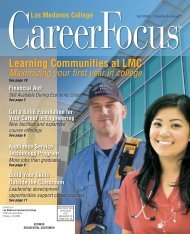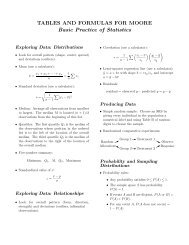Education Policy Brief Teacher Professional Development
Education Policy Brief Teacher Professional Development
Education Policy Brief Teacher Professional Development
Create successful ePaper yourself
Turn your PDF publications into a flip-book with our unique Google optimized e-Paper software.
University of Delaware<br />
<strong>Education</strong> Research & <strong>Development</strong> Center<br />
<strong>Education</strong> <strong>Policy</strong> <strong>Brief</strong><br />
VOLUME 15, MAY 2004<br />
<strong>Teacher</strong> <strong>Professional</strong> <strong>Development</strong><br />
“<strong>Teacher</strong>s and educators around the country are beginning to see that the goal of improving<br />
teaching - improving students’ opportunities to learn - can only be reached by<br />
a path that the United States has never taken before. This new path moves educators<br />
away from a view of teaching as a solitary activity, owned personally by each teacher.<br />
It moves them toward a view of teaching as a professional activity open to collective<br />
observations, study, and improvement. It invites ordinary teachers to recognize and<br />
accept the responsibility for improving not only their own practice, but the shared<br />
practice of the profession. For this new path to be traveled, however, teachers will<br />
need to open their classroom doors and, rather than evaluating each other, begin<br />
studying their practices as a professional responsibility common to all.”<br />
(Hiebert, Gallimore, and Stigler, 2003)<br />
If you would like more information or if you have questions regarding this <strong>Education</strong> <strong>Policy</strong> <strong>Brief</strong>, contact<br />
Margarete Kedzior, M.S.<br />
UNIVERSITY OF DELAWARE EDUCATION RESEARCH & DEVELOPMENT CENTER<br />
Phone: 302-831-4433<br />
E-mail: kedzior@udel.edu<br />
Prepared by Margarete Kedzior, M.S., and Steve Fifield, Ph.D., Delaware <strong>Education</strong> Research & <strong>Development</strong><br />
Center. The <strong>Education</strong> <strong>Policy</strong> <strong>Brief</strong> series is available online at http://www.rdc.udel.edu.<br />
The University of Delaware is committed to assuring equal opportunity to all persons and does not discriminate on the basis of<br />
race, color, gender, religion, ancestry, national origin, sexual orientation, veteran status, age, or disability in its educational programs,<br />
activities, admissions or employment practices as required by Title IX of the <strong>Education</strong> Amendments of 1972, Sections<br />
503 and 504 of the Rehabilitation Act of 1973, Titles VI and VII of the Civil Rights Act of 1964, the Americans with Disabilities<br />
Act, Executive Orders 11246 and 11375 and other applicable statutes. Inquiries concerning Title IX, Section 503 and 504 compliance,<br />
Executive Order 11246 and information regarding campus accessibility and Title VI should be referred to the Affirmative<br />
Action Director, 305 Hullihen Hall, 302-831-2835, 302-831-4552 (TDD).
INTRODUCTION<br />
Recent developments in education policy and practice, such as the No Child Left Behind Act and high-stakes<br />
testing, increase expectations on educators to improve student learning. “Research shows that teacher expertise<br />
can account for about 40 percent of the variance in students’ learning in reading and mathematics achievement-more<br />
than any other single factor, including student background…” (Rhoton & Stile, 2002, p. 1).<br />
Research also demonstrates that positive changes occur in teachers’ practices when they experience sustained,<br />
high quality professional development. “However, the research on learning…and that on effective teacher<br />
development…suggest that teacher development as carried out in most schools today is not designed to develop<br />
the teacher expertise needed to bring about improved student learning” (Rhoton & Stile, 2002, p. 1). So what<br />
are the characteristics of high quality teacher professional development<br />
RESEARCH FINDINGS<br />
What are the characteristics of high quality teacher professional development<br />
There can be no “one size fits all” approach to effective teacher professional development. “Differences in<br />
communities of school administrators, teachers, and students uniquely affect professional development<br />
processes and can strongly influence the characteristics that contribute to professional development’s<br />
effectiveness”(Guskey, 2003, p. 47). To have the greatest impact, professional development must be designed,<br />
implemented, and evaluated to meet the needs of particular teachers in particular settings (Guskey, 1995). But<br />
several characteristics of high quality teacher professional development can be derived from research on a wide<br />
variety of approaches (Guskey, 2003). The following are some of the most consistently cited factors.<br />
1. Content-focused: Several studies demonstrate that teachers’ skills and understandings are directly<br />
related to the degree that professional development experiences focus on subject matter content (Birman,<br />
Desimone, Garet, & Porter, 2000). Being ‘content-focused’ means also considering students’ prior<br />
knowledge related to the content, and strategies teachers can use to actively engage students in developing<br />
new understandings (Cohen, Hill, & Kennedy, 2002).<br />
2. Extended: Extended professional development experiences, rather than one-time sessions, allow for<br />
more substantive engagement with subject matter, more opportunities for active learning, and the development<br />
of coherent connections to teachers’ daily work (Birman, Desimone, Garet, & Porter,<br />
2000).<br />
3. Collaborative: “<strong>Teacher</strong> learning is most likely when teachers collaborate with professional peers,<br />
both within and outside of their schools, and when they gain further expertise through access to external<br />
researchers and program developers” (King & Newmann, 2000, p. 576). “<strong>Professional</strong> development<br />
activities that include collective participation–that is, the participation of teachers from the same department,<br />
subject, or grade–are more likely to afford opportunities for active learning and are more<br />
likely to be coherent with teachers’ other experiences” (Birman, Desimone, Garet, & Porter, 2000, p.<br />
30).<br />
4. Part of Daily Work: <strong>Professional</strong> development should be largely school-based and incorporated into<br />
the day-to-day work of teachers (National Partnership for Excellence and Accountability in Teaching,<br />
no date).<br />
5. Ongoing: Several studies indicate that professional development should be continuous, not episodic,<br />
and include follow-up and support for further learning (Association for Supervision and Curriculum <strong>Development</strong>,<br />
2003).<br />
6. Coherent & Integrated: <strong>Professional</strong> development should incorporate experiences that are consistent<br />
with teachers’ goals; aligned with standards, assessments, and other reform initiatives; and informed by<br />
the best available research evidence (Birman, Desimone, Garet, Porter, & Yoon, 2002; Guskey, 2003).<br />
7. Inquiry-based: <strong>Professional</strong> development should promote continuous inquiry and reflection through<br />
active learning. “Active learning encourages teachers to become engaged in meaningful discussion,<br />
planning, and practice as part of the professional development activity” (Birman, Desimone, Garet, &<br />
Porter, 2000, p. 30-31).<br />
8. <strong>Teacher</strong>-driven: <strong>Professional</strong> development should respond to teachers’ self-identified needs and<br />
interests in order to support individual and organizational improvements. <strong>Professional</strong> development is<br />
more meaningful to teachers when they exercise ownership of its content and process (King & Newmann,<br />
2000).<br />
2
9. Informed by Student Performance: Analyses of impacts on student performance should inform<br />
professional development (Guskey, 2003; National Partnership for Excellence and Accountability in<br />
Teaching, no date, Association for Supervision and curriculum <strong>Development</strong>, 2003).<br />
10. Self-evaluation: <strong>Professional</strong> development should include procedures for self-evaluation to guide<br />
teachers in their ongoing improvement efforts (Guskey, 2003).<br />
What are models of high quality teacher professional development<br />
There are many models of professional development that incorporate several of these characteristics of high<br />
quality. Recent research and policy in professional development support moving away from ‘sit-and-get’<br />
workshops on general topics toward teacher-driven efforts to identify and solve instructional problems rooted<br />
in their daily work. Each of the following examples of professional development incorporates several<br />
characteristics of high quality. These three examples also reflect some of the diversity of possible approaches<br />
by focusing on new teacher development, student thinking, and lesson design, respectively.<br />
• Mentoring: Mentoring gives novice and master teachers opportunities to learn from each other. It can<br />
help new teachers learn to creatively and effectively meet the day-to-day challenges of teaching.<br />
Mentoring occurs around activities such as classroom observations, coaching, feedback, and the collaborative<br />
teaching. Mentoring can have dramatic effects on teachers, that include increased retention, improved<br />
attitudes, increased feelings of efficacy and control, and experience using a wider range of instructional<br />
strategies (Smith, 2002).<br />
• Content-Based Collaborative Inquiry (CBCI) & Cognitively Guided Instruction (CGI): In CBCI<br />
and CGI, teachers work together to create deeper understandings of how their students think about and<br />
understand particular subjects. In CBCI, teachers and facilitators pose questions about students’ understandings,<br />
collect and analyze data, share the results with their colleagues, and collaborate to create instructional<br />
solutions. In the process, teachers build understandings of content and pedagogy that support student<br />
learning (Bray, Gause-Vega, Goldman, Secules, & Zech, 2000). In CGI, teachers create models of how<br />
students think and solve problems. <strong>Teacher</strong>s use these models of student thinking to develop instructional<br />
materials that address students’ learning needs. CGI provides opportunities for teachers to deepen their own<br />
understandings of subject matter, while they develop ways to teach it more effectively (Carpenter, Fennema,<br />
Franke, & Levi, 2001).<br />
• Lesson Study: Lesson study is a multi-step process in which teachers work together to create, study, and<br />
improve their lessons. In this approach, a member of the study group teaches a lesson while others make<br />
detailed observations. After the lesson, all members of the group meet to discuss their observations and to<br />
consider how the lesson might be improved. The lesson is taught again to a different group of students, and<br />
the process of observation, collaborative data analysis, and lesson revision is repeated (Fernandez and<br />
Chokshi, 2002; Watanabe, 2002). Lesson study is another model of using collaborative self-study of<br />
teachers’ practices as a means to support teacher growth and instructional improvement (Mid-Atlantic<br />
Eisenhower Regional Consortium, 2002).<br />
What are the effects of professional development on teaching practices and student learning<br />
A number of studies report positive effects of teacher professional development on teaching practices. Many<br />
studies rely on teachers’ self-reports of the impact of professional development. Measures based on independent<br />
observations of teachers’ classroom practices are less common. Few studies examine the effect of teacher<br />
professional development on student learning.<br />
.<br />
• A review of several professional development programs suggests that “the content of in-service programs<br />
does indeed make a difference, and that programs that focus on subject-matter knowledge and on student<br />
learning of particular subject matter are likely to have larger positive effects on student learning than are<br />
programs that focus mainly on teaching behaviors” (Kennedy, 1998, p. 9). This review concludes that,<br />
compared to other models, CGI approaches (see above) had the greatest effect on students’ basic skills,<br />
reasoning, and problem-solving performance (Berne & Wilson, 1999; Cohen, Hill, & Kennedy, 2002;<br />
Kennedy, 1998).<br />
3
• Further research on CGI suggests that when teachers collaborate they are more likely to take risks, learn<br />
from mistakes, and share successful strategies. “When teachers reflect on their own classroom practices in<br />
principled ways, teachers can integrate their practical knowledge with research-based knowledge in ways<br />
that contribute to more successful practices” (Carpenter, Fennema, Franke, & Levi, 2001, p. 655).<br />
“<strong>Teacher</strong>s who participated in CGI taught problem solving significantly more and taught number facts and<br />
skills significantly less. The teachers used different instructional strategies, listened to students more, and<br />
believed that instruction would build on what students know. Analyses of student achievement showed that<br />
students of CGI teachers recalled number facts at a higher level, [and exceeded] students in control classrooms<br />
in problem solving and confidence” (Berne & Wilson, 1999, p. 184).<br />
• Birman et. al. (2001) studied a national sample of 1,027 mathematics and science teachers who participated<br />
in professional development activities supported by federal Eisenhower funds. This study sought to identify<br />
core features of professional development that have significant positive effects on teacher knowledge,<br />
skills, and changes in classroom practices. Based on teachers’ self-reports, the results show that incorporating<br />
active learning in professional development increases knowledge and skills, and changes teachers’<br />
classroom practices. In addition, the degree to which the activity is consistent with and explicitly connected<br />
to specific instructional and institutional goals is directly related to increased teacher learning and improved<br />
classroom practices (Birman, Desimone, Garet, & Porter, 2000).<br />
• The Michigan English Language Framework (MELAF) was a federally-funded, statewide reform project to<br />
develop a standards-based curriculum, instruction and assessment framework. Associated professional<br />
development activities were sustained, content-focused, and teacher-driven. Participants compared their<br />
personal understandings of language arts content with state standards and other models of language arts<br />
content; participated in study groups around relevant professional literature; attended workshops in which<br />
they experienced and critiqued exemplary practices; and collaboratively planned a culminating statewide<br />
conference. <strong>Teacher</strong>s in this project reported changes in their personal literacy practices, as well as in their<br />
teaching. Many came “to use reading and writing as reflective tools for learning from their classroom<br />
practices” (Dutro, Fisk, Koch, Roop, & Wixson, 2002, p. 795). MELAF gave teachers the opportunity to<br />
articulate and refine their philosophies of teaching and learning, and provided support to more purposefully<br />
apply these philosophies in their classrooms.<br />
• Lewis Elementary School is an urban school in Texas in which 93% of the students come from low-income<br />
families. In this school, professional development aligned with district and state accountability requirements<br />
contributed to dramatic improvement in students’ reading achievement. <strong>Professional</strong> development supported<br />
implementation of the “Success for All” reading and math curriculum by focusing on shared learning<br />
goals, teaching strategies, and high expectations for student achievement. Collaborative work in grade-level<br />
teams contributed to teachers’ individual and collective professional growth (King & Newmann, 2000).<br />
What are the barriers to implementation of effective professional development<br />
The nature of professional development as described here entails a different view of teaching as a professional<br />
activity. It creates opportunities for teachers to take charge of their professional learning and practice, but it<br />
also places new demands on them, on school administrators, and on education policy-makers. <strong>Professional</strong><br />
development that seeks to support teaching as an ongoing inquiry into more effective classroom practice must<br />
overcome several significant barriers to change.<br />
• The structure of professional development and teachers’ time: <strong>Teacher</strong>s may hesitate to commit<br />
time to professional development that extends beyond the regular school day and year. They often prefer<br />
one-day workshops during the school year to extended commitments during the summer (Birman, Desimone,<br />
Garet, Porter, & Yoon, 2001).<br />
• The content of professional development: <strong>Professional</strong> development that focuses on subject matter<br />
content and classroom practices can meet with resistance. Even in supportive environments, some individuals<br />
may be uncomfortable sharing their understandings and beliefs with colleagues and supervisors<br />
(Birman, Desimone, Garet, Porter, & Yoon, 2001).<br />
• School factors: It is challenging and time-consuming to design and implement professional development<br />
that incorporates multiple characteristics of high quality. As instructional leaders and institutional change<br />
4
agents, school administrators and policy makers must address school-level obstacles to teachers’ efforts to<br />
improve their practices (Birman, Desimone, Garet, Porter, & Yoon, 2001). Among these obstacles is the<br />
rigid structure of teachers’ work days, which allows too little time for individual and collaborative work<br />
toward instructional improvement.<br />
• District Factors: “<strong>Teacher</strong>s often perceive that district reforms are fragmented and uncoordinated, and<br />
this likely…impedes voluntary participation in professional development...” (Supovitz & Zief, 2000, p. 3).<br />
• Costs: High quality professional development is expensive, perhaps more than twice the amount that<br />
districts typically spend per teacher (Birman, Desimone, Garet, Porter, & Yoon, 2001). Given the high<br />
costs, it may be wise to invest in “a core community of teacher leaders who are willing to share their<br />
learning with others…” “By strengthening effective teachers, helping them create local communities with<br />
other strong teachers, and giving them time to reflect on district or school conditions and their colleagues’<br />
learning, they may be able to assume critical leadership roles” (Dutro, Fisk, Koch, Roop, & Wixson, 2002,<br />
p. 808).<br />
DELAWARE SITUATION<br />
A number of teacher professional development initiatives that are designed to incorporate multiple characteristics<br />
of high quality (see page 2) are underway in Delaware’s public schools. Here are three examples:<br />
• <strong>Teacher</strong>-to-<strong>Teacher</strong> Cadre: More than 100 Delaware public school teachers comprise this cadre of<br />
teacher-leaders who provide professional development services to colleagues in their school districts. The<br />
professional development done by the cadre is intended to be embedded in teachers’ daily work, shaped by<br />
teachers’ and students’ needs, and sustained.<br />
• <strong>Professional</strong> <strong>Development</strong> Clusters: These professional development experiences can combine<br />
coursework, action research, study groups, and independent research. <strong>Professional</strong> <strong>Development</strong> Clusters<br />
are intended to be delivered at a level of rigor equivalent to graduate study, to improve educators’ knowledge<br />
and skills in order to impact student learning, and to be aligned with Delaware education standards.<br />
Topics of approved clusters include literacy, educational technology, international education, and cultural<br />
diversity (see ).<br />
• Lesson Study: Since the fall of 2002, the Mathematics and Science <strong>Education</strong> Resource Center at the<br />
University of Delaware has used federal grant funds to support lesson study for science faculty in six public<br />
middle schools in Delaware. These teams collaboratively set educational goals, plan lessons, and conduct<br />
public lessons. The teachers and observers then analyze the lessons and their impact on student learning.<br />
Experience in this effort to embed professional develop in teachers’ daily work points to the need to<br />
creatively restructure teachers’ workdays to make time available for self-study and collaboration with<br />
colleagues.<br />
POLICY QUESTIONS FOR CONSIDERATION<br />
• What administrative and institutional barriers frustrate Delaware teachers’ efforts to “accept the<br />
responsibility for improving not only their own practice, but the shared practice of the profession” (Hiebert,<br />
Gallimore, and Stigler, 2003)<br />
• What is the impact of the <strong>Professional</strong> <strong>Development</strong> and Educator Accountability Act of 2000 on<br />
teachers’ opportunities to create and participate in high quality professional development<br />
• What is the impact of new approaches to professional development on teachers’ classroom practices and<br />
students’ learning in Delaware’s public schools<br />
5
REFERENCES<br />
Association for Supervision and Curriculum <strong>Development</strong>. (2003) What professional development structures best affect<br />
classroom instruction Translating <strong>Education</strong> Research into Action. 1(15), 1-4.<br />
http://www.ascd.org/publications/researchbrief/volume1//v1n15.html . Retrieved November 2003.<br />
Berne, J. & Wilson, S., M. (1999) <strong>Teacher</strong> learning and the acquisition of professional knowledge: An examination of<br />
research on contemporary professional development. In A. Iran-Nejad & P. D. Pearson (Ed.), Review of Research<br />
in <strong>Education</strong> (pp. 173-209). Washington, DC: American <strong>Education</strong>al Research Association.<br />
Birman, B. F., Desimone, L., Garet, M. S., & Porter, A. C. (2000) Designing professional development that works.<br />
<strong>Education</strong>al Leadership. 57(8), 28-33.<br />
Birman, B. F., Desimone, L., Garet, M. S., Porter, A. C., & Yoon, K. S. (2001) What makes professional development<br />
effective Results from a national sample of teachers. American <strong>Education</strong>al Research Journal. 38(4),<br />
915-945.<br />
Birman, B. F., Desimone, L., Garet, M. S., Porter, A. C., & Yoon, K. S. (2002) Effects of professional development<br />
on teachers’ instruction: Results form a three-year longitudinal study. <strong>Education</strong>al Evaluation and <strong>Policy</strong><br />
Analysis. 24(2), 81-112.<br />
Bray, M. H., Gause-Vega, C. L., Goldman, S. R., Secules, T., & Zech, L. K. (2000) Content-based collaborative inquiry:<br />
A professional development model for sustaining educational reform. <strong>Education</strong>al Psychologist. 35(3),<br />
207-217.<br />
Carpenter, T. P., Fennema, E., Franke, M. L., & Levi, L. (2001) Capturing teachers’ generative change: A Follow-up<br />
study of professional development in mathematics. American <strong>Education</strong>al Research Journal. 38(3), 653-689.<br />
Cohen, D., Hill, H., & Kennedy, M. (2002) The benefit to professional development. American Educator. 26(2), 22-<br />
25.<br />
Dutro, E., Fisk, M. C., Koch, R., Roop, L. J., & Wixson, K. (2002) When state policies meet local district contexts:<br />
Standards-based professional development as a means to individual agency and collective ownership. <strong>Teacher</strong>s<br />
College Record. 104(4), 787-811.<br />
Fernandez, C., & Chokshi, S. (2002) A practical guide to translating lesson study for a U.S. setting. Phi Delta Kappan.<br />
84(2), 128-134.<br />
Guskey, T. R. (1995) Results-oriented professional development: In search of an optimal mix of effective practices,<br />
North Central Regional <strong>Education</strong>al Laboratory. http://www.ncrel.org/sdrs/areas/rpl_esys/pdlitrev.htm . Retrieved<br />
November 2003.<br />
Guskey, T. R. (2003) Analyzing lists of the characteristics of effective professional development to promote visionary<br />
leadership. NASP Bulletin. 87(637), 38-54.<br />
Hiebert, J., Gallimore, R., & Stigler, J. W. (2003) The new heroes of teaching. <strong>Education</strong> Week 23(10), 56, 42<br />
http://www.edweek.org/ew/ew_printstory.cfmslug=10hiebert.h23 . Retrieved November 2003.<br />
Kennedy, M. (1998) Form and substance in inservice teacher education, Research monograph 13, National Institute for<br />
Science <strong>Education</strong>, University of Wisconsin–Madison,<br />
http://www.msu.edu/~mkennedy/publications/docs/NISE/NISE.pdf . Retrieved September 2003.<br />
King, M. B. & Newmann, F. M. (2000) Will teacher learning advance school goals Phi Delta Kappan. 81(8), 576-<br />
580.<br />
Mid-Atlantic Eisenhower Regional Consortium. (2002) What is lesson study Research for Better Schools. V(2), 1-2.<br />
National Partnership for Excellence and Accountability in Teaching. (no date) Characteristics of effective professional<br />
development. http://www.ericsp.org/pages/digests/NPEAT.htm . Retrieved November 2003.<br />
Rhoton, J., & Stiles, K. E. (2002) Exploring the professional development design process: Bringing an abstract<br />
framework into practice. Science Educator. 11(1), 1-8.<br />
Smith, S. (2002) <strong>Teacher</strong> mentoring and collaboration. Journal of Special <strong>Education</strong> Technology. 17(1), 47-48.<br />
Supovitz, J., & Zief, S. G. (2000) Why they stay away: Survey reveals invisible barriers to teacher participation. Journal<br />
of Staff <strong>Development</strong>. 21(4). http://www.nsdc.org/library/publications/jsd/supovitz214.cfm . Retrieved<br />
January 2004.<br />
Watanabe, T. (2002) Learning from Japanese lesson study. <strong>Education</strong>al Leadership. 59(6), 36-39.<br />
6


